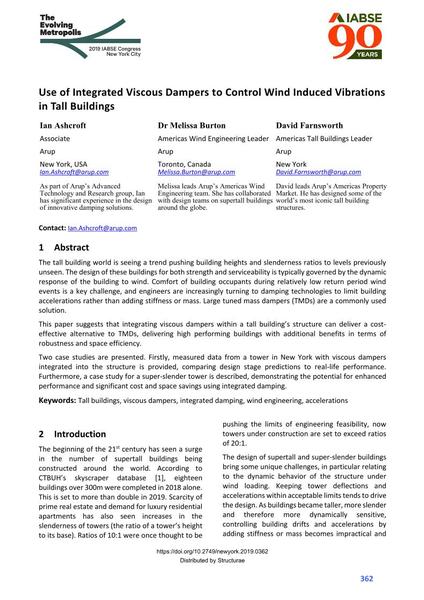Use of Integrated Viscous Dampers to Control Wind Induced Vibrations in Tall Buildings

|
|
|||||||||||
Bibliographic Details
| Author(s): |
Ian Ashcroft
(Arup)
Melissa Burton (Arup) David Farnsworth (Arup) |
||||
|---|---|---|---|---|---|
| Medium: | conference paper | ||||
| Language(s): | English | ||||
| Conference: | IABSE Congress: The Evolving Metropolis, New York, NY, USA, 4-6 September 2019 | ||||
| Published in: | The Evolving Metropolis | ||||
|
|||||
| Page(s): | 362-368 | ||||
| Total no. of pages: | 7 | ||||
| DOI: | 10.2749/newyork.2019.0362 | ||||
| Abstract: |
The tall building world is seeing a trend pushing building heights and slenderness ratios to levels previously unseen. The design of these buildings for both strength and serviceability is typically governed by the dynamic response of the building to wind. Comfort of building occupants during relatively low return period wind events is a key challenge, and engineers are increasingly turning to damping technologies to limit building accelerations rather than adding stiffness or mass. Large tuned mass dampers (TMDs) are a commonly used solution. This paper suggests that integrating viscous dampers within a tall building’s structure can deliver a cost- effective alternative to TMDs, delivering high performing buildings with additional benefits in terms of robustness and space efficiency. Two case studies are presented. Firstly, measured data from a tower in New York with viscous dampers integrated into the structure is provided, comparing design stage predictions to real-life performance. Furthermore, a case study for a super-slender tower is described, demonstrating the potential for enhanced performance and significant cost and space savings using integrated damping. |
||||
| Keywords: |
accelerations tall buildings viscous dampers wind engineering integrated damping
|
||||
